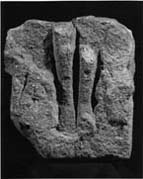Select a site alphabetically from the choices shown in the box below. Alternatively, browse sculptural examples using the Forward/Back buttons.
Chapters for this volume, along with copies of original in-text images, are available here.
Object type: Part of cross-shaft and -head [1]
Measurements: H.29.2 cm (11.5 in); W. 23.5 cm (9.25 in); D. 12.1 cm (4.75 in)
Stone type: Coarse-grained, massive yellow sandstone
Plate numbers in printed volume: Pl. 17.81-84
Corpus volume reference: Vol 1 p. 51
(There may be more views or larger images available for this item. Click on the thumbnail image to view.)
A (broad): Part of crude roll moulding survives on either side of the feet of a large standing figure.
B (narrow): Under the soffit of the arm is a small panel of plain plait. Below is pattern D with surrounding strands, framed by a flat-band moulding.
C (broad): A central figure is apparently seated on a bar-like feature which could be a bench or seat shown in profile. The head is missing save for the pointed chin. Its rounded shoulders are flanked by what some have seen as wings (Collingwood 1927, 101), but which could be curtains or an architectural feature. Its robe is ankle-length and there has been an attempt to indicate the position of the drapery over the knees, and its folds below. At the feet of the figure are lush plant motifs, apparently composites of the leaf-flower type.
D (narrow): The soffit under the arm is plain. Below, framed in a flat-band moulding, is a crouching animal. It seems to be winged, has a long neck and reptilian head, which is bent to bite its front leg. Its tail is curved over its back.
This is a difficult piece to date, since it is apparently derived from a good model, possibly a manuscript. The roundels which indicate the knees thrust forward in a seated position occur also on a seated Christ at Dewsbury, Yorkshire (Collingwood 1915, 162a). If there are draped curtains at the side of the figure and flowers at its feet, then this is also a feature of Evangelist portraits in manuscripts. However, the heavy shoulders, and the straight hem-line with V-shaped folds above are markedly different from draped figures in pre-Viking manuscripts, and more closely resemble the figures of c. A.D. 1000 of the Durham group. The interlace on face B has been compared with a much more freely executed pattern from Monkwearmouth (no. 6: Adcock 1974, 144, fig. 36B). However, although the fashion for surrounded patterns may start in the early ninth century, this type of plait continues in use into the eleventh. Similarly the large-scale figure on A, extending from the shaft to the head, which is plausibly a crucified Christ, is a type which occurs in English sculpture about 800, but remains popular up to the Conquest (Collingwood 1927, 99-105). The plant forms and the winged reptile reflect Mercian taste of the early ninth century, whatever was the immediate model for this cross. It is just possible that such a model could have existed at Billingham itself, since the inscribed name-stone (no. 13) is early and of high quality (perhaps reflecting a monastic environment), and the fragment of plant-scroll (no. 16) provides a possible prototype for the plants at the feet of the figure. Moreover, Billingham was one of the holdings given to the Lindisfarne community by Bishop Ecgred (830-845).



